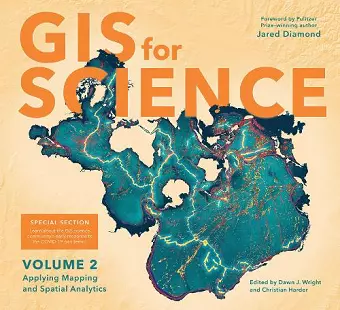GIS for Science
Applying Mapping and Spatial Analytics, Volume 2
Christian Harder editor Dawn J Wright editor
Format:Paperback
Publisher:ESRI Press
Published:4th Feb '21
Should be back in stock very soon

Merging the rigor of the scientific method with the technologies of GIS
GIS for Science, Volume 2: Applying Mapping and Spatial Analytics brings to life a continuing collection of current, real-world examples of scientists using geographic information systems (GIS) and spatial data science to expand our understand of the world. Co-edited by Esri Chief Scientist Dawn Wright and Esri Technology Writer and Information Designer Christian Harder and with a foreword by Pulitzer Prize winner Jared Diamond, these case studies are part of a global effort to find ways to sustain a livable environment for all life on this planet.
The contributors of GIS for Science, Volume 2: Applying Mapping and Spatial Analytics represent a cross section of scientists who employ data gathered from satellites, aircraft, ships, drones, and myriad other remote-sensing and on-site technologies. This collected data is brought to life with GIS and the broader realm of spatial data science to study a range of issues relevant to our understanding of planet Earth—including epidemiology in light of the COVID-19 pandemic; sustainable precision agriculture; predicting geological processes below the surface of the earth; leveraging GIS near-realtime disaster response, recovery, resilience and reporting; the latest innovations in monitoring air quality; and more. Their stories also show in very practical terms how ArcGIS software and the ArcGIS Online cloud-based system work as a comprehensive geospatial platform to support research, collaboration, spatial analysis, and science communication across many settings and communities. A rich supplementary web site—gisforscience.com—includes actual data along with additional maps, videos, web apps, story maps, workflows and snippets of computer code, including Python notebooks, for readers curious to learn more.
Written for professional scientists, the swelling ranks of citizen scientists, and anyone interested in science and geography, GIS for Science, Volume 2: Applying Mapping and Spatial Analytics offers wonderful examples of our impulse to dream, discover, and understand, as coupled with the rigor and discipline of the scientific method and the foundation of geography. See how scientists from a variety of disciplines are solving some of the world's most pressing problems using geographic information systems—GIS.
"GIS provides the platform that allows us to generate a holistic perspective of the natural world. Given the relevance of this geospatial perspective for all aspects of society, I hope this beautiful book will inspire a wide range of people to embrace the "Science of Where."
-- Thomas Crowther, Director, Global Forest Biodiversity Initiative, ETH-Zurich
* Thomas Crowther *“GIS for Science is no standard book. With vivid imagery, lucid writing, interactive learning, and compelling, relevant examples from Earth’s past, present, and future, GIS for Science is a modern manual for understanding that integrative spatial analysis and visualization is the big data revolution most vital to the quality of all life on Earth.”
-- Healy Hamilton, Chief Scientist of NatureServe
* Healy Hamilton *“ This is a geoscience book for the 21st century! Cutting edge research examples and gloriously illustrated state of the art GIS-enabled techniques come together to show us how to understand our planet in ways not possible even a few years ago."
-- Margaret Leinen, Director of Scripps Institution of Oceanography -
* Margaret Leinen *"GIS has become THE foundational tool for all things environmental – from conservation to climate change to environmental justice. This astonishing book beautifully displays GIS in all its scientific, artistic, and creative splendor.”
-- Peter Kareiva, Director, UCLA Institute of the Environment and Sustainability
* Peter KareiISBN: 9781589485877
Dimensions: unknown
Weight: unknown
232 pages